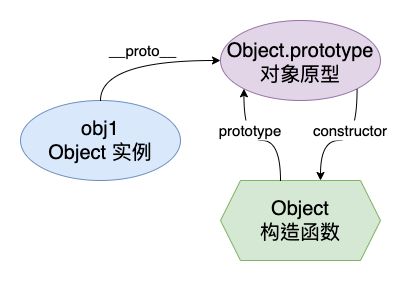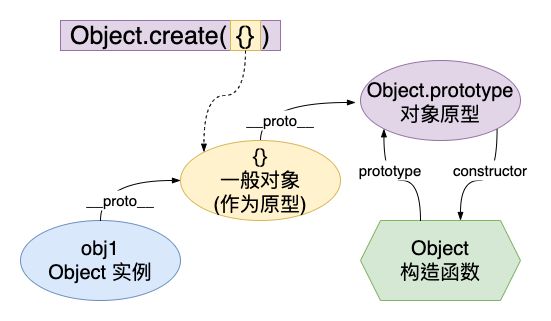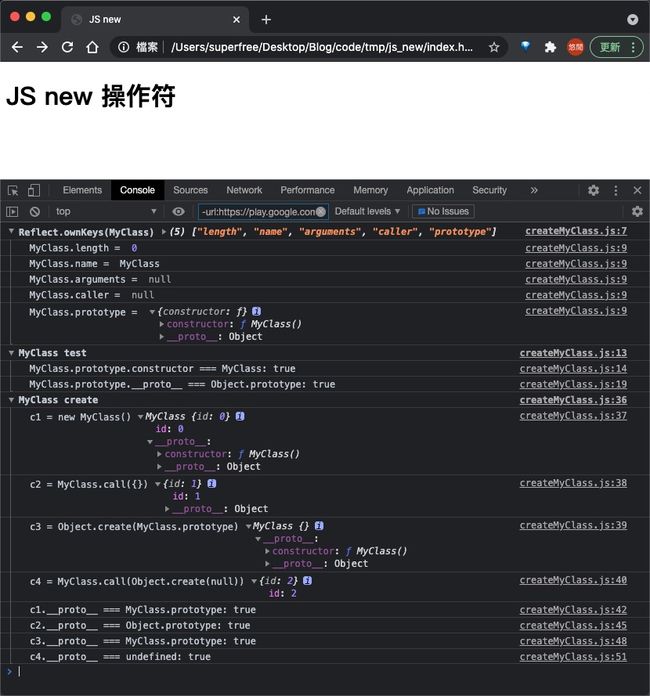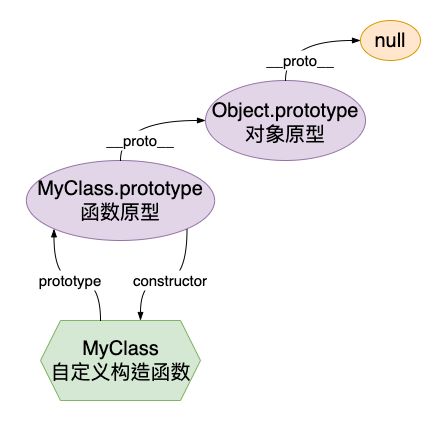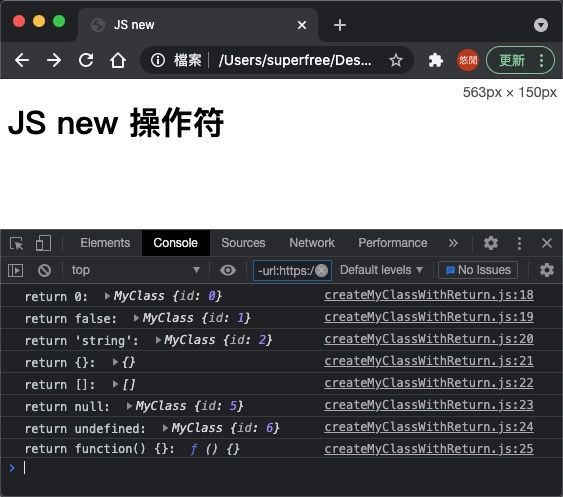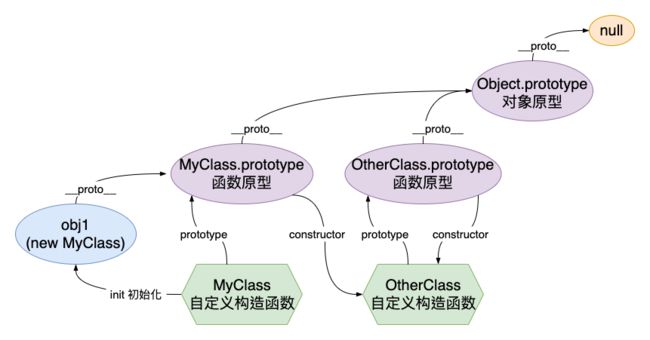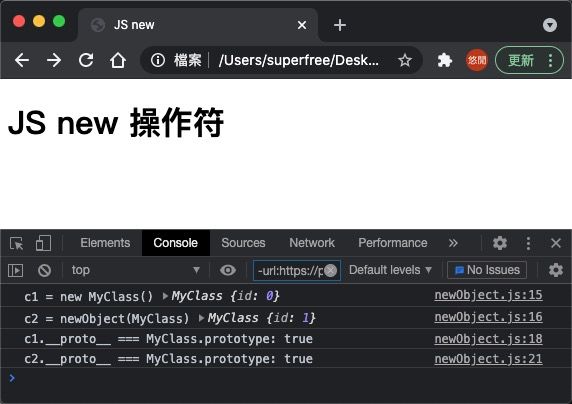JS 基础: 从 5 种创建对象的方式看 new 操作符的作用与实现
JS 基础: 从 5 种创建对象的方式看 new 操作符的作用与实现
文章目录
- JS 基础: 从 5 种创建对象的方式看 new 操作符的作用与实现
- 前言
- 正文
-
- 创建 Object 对象的五种方式
-
- 使用 Object.create(proto) 创建对象
- 自定义类型
-
- 函数属性 & 原型
- 创建自定义类型对象
- 自定义类型小结
- 再谈对象的创建
-
- 1. 构造函数的返回值
- 2. 自定义对象修改原型后再创建
- new 关键字实现
- 结语
- 其他资源
-
- 参考连接
- 完整代码参考
前言
本篇要来谈谈 JS 语言中的创建普通 Object 对象的五种方法,并引出类型相关的属性与 new 关键字在创建对象的时候所表现的行为,最后给出一个 new 关键字的实现。
正文
创建 Object 对象的五种方式
首先第一段我们先来熟悉一下,在 JS 语言中我们能够使用的 5 种创建对象的方式
createObject.js
const obj1 = {
}
const obj2 = Object()
const obj3 = new Object()
const obj4 = Object.create({
})
const obj5 = Object.create(null)
console.log('obj1 = {}', obj1)
console.log('obj2 = Object()', obj2)
console.log('obj3 = new Object()', obj3)
console.log('obj4 = Object.create()', obj4)
console.log('obj5 = Object.create(null)', obj5)
console.log(
`obj1.__proto__ === Object.prototype = `,
obj1.__proto__ === Object.prototype
)
console.log(
`obj2.__proto__ === Object.prototype = `,
obj2.__proto__ === Object.prototype
)
console.log(
`obj3.__proto__ === Object.prototype = `,
obj3.__proto__ === Object.prototype
)
console.log(
`obj4.__proto__.__proto__ === Object.prototype = `,
obj4.__proto__.__proto__ === Object.prototype
)
console.log(`obj5.__proto__ = `, obj5.__proto__)
五种创建方式分别对应 obj1 ~ obj5,我们可以看到五种方式都创建出一个新的对象,区别在于原型对象(部分浏览器透过 __proto__ 属性来对外暴露),前三种方式都指向了 Object.prototype 属性,也就是之前 JS 基礎:Prototype Chain 原型鏈 提过的:
构造函数、原型对象与实例对象之间的关系。
使用 Object.create(proto) 创建对象
特别注意的是后面两种创建对象的方式:
- 对于
obj4:我们发现obj4.__proto__并不直接指向Object.prototype而是需要再访问一层__proto__才会是Object.prototype,其实就是下面这样一个结构
Object.create({}) 将以参数作为原型创建一个新的对象
- 对于
obj5:我们传入null作为原型,所以当然就不存在所谓的原型对象,__proto__就变成了undefined
自定义类型
上面我们创建的是内置的 Object 类型的对象,下面我们定义一个自定义类型 MyClass:
createMyClass.js
let uid = 0
function MyClass() {
this.id = uid++
}
下面先上代码再来一一解说
console.group(`Reflect.ownKeys(MyClass)`, Reflect.ownKeys(MyClass))
for (const key of Reflect.ownKeys(MyClass)) {
console.log(`MyClass.${
key} = `, MyClass[key])
}
console.groupEnd()
console.group('MyClass test')
console.log(
`MyClass.prototype.constructor === MyClass: ${
MyClass.prototype.constructor === MyClass
}`
)
console.log(
`MyClass.prototype.__proto__ === Object.prototype: ${
MyClass.prototype.__proto__ === Object.prototype
}`
)
console.groupEnd()
const c1 = new MyClass()
const c2 = {
}
MyClass.call(c2)
const c3 = Object.create(MyClass.prototype)
const c4 = Object.create(null)
MyClass.call(c4)
console.group('MyClass create')
console.log(`c1 = new MyClass()`, c1)
console.log(`c2 = MyClass.call({})`, c2)
console.log(`c3 = Object.create(MyClass.prototype)`, c3)
console.log(`c4 = MyClass.call(Object.create(null))`, c4)
console.log(
`c1.__proto__ === MyClass.prototype: ${
c1.__proto__ === MyClass.prototype}`
)
console.log(
`c2.__proto__ === Object.prototype: ${
c2.__proto__ === Object.prototype}`
)
console.log(
`c3.__proto__ === MyClass.prototype: ${
c3.__proto__ === MyClass.prototype}`
)
console.log(`c4.__proto__ === undefined: ${
c4.__proto__ === undefined}`)
console.groupEnd()
函数属性 & 原型
首先第一步我们先来看看作为一个函数会存在哪些属性(第一块输出)
内置函数类型有以下属性:
- length: 形式参数个数
- name: 函数名称
- arguments: 参数列表
- caller: 调用主体
- prototype: 原型对象
这边我们就是简单定义了一个函数后面要作为构造函数使用,所以 prototype 指向的原型对象也很单纯,就跟前面的 Object 关系雷同
创建自定义类型对象
接下来是 obj1 ~ obj4 的对象创建
obj1:第一种就是直接使用new MyClass()来创建对象,也是平常我们最常使用的方式obj2:第二种稍微改变以下,我们先创建一个普通对象{},然后在调用构造函数对其进行初始化。其实这就跟以前描述过的 new 关键字的行为很像(new MyClass会在 new 关键字创建对象、使用 MyClass 构造函数初始化),然而下面我们可以看到,obj2.__proto__的原型直接指向Object.prototpye了,也就是说类型信息(MyClass 与其原型)并没有如我们所想的出现在obj2的原型链上,也就是说对obj2调用MyClass的原型方法是无效的obj3:既然第二种没有原型,那我们就采用上面提过的Object.create的方式来创建对象吧;但是我们从输出中看到类型是对了(__proto__指向MyClass.prototype),但是却不存在 id 也就是仅仅添加了类型信息而没有执行构造函数,这边我们已经隐隐约约看出来 new 关键字要怎么实现了,后面再提obj4:第四种与第二种类似,区别在于我们的原始对象使用Object.create(null),也就是一个不包括原型(类型信息)的对象来作为载体
自定义类型小结
到此我们已经大致明白一个自定义类型与创建对象的时候类型信息(原型对象)要如何指定和进行初始化了
Object.create(proto)能根据我们指定的原型来创建对象(返回对象的__proto__原型指向参数的原型),但不会对对象进行初始化Ctor.call(obj)透过以某个对象作为上下文调用构造函数,相当于是对该对象进行初始化
再谈对象的创建
在进入最终 new 关键字的实现之前,我们再来探索以下 prototype 原型对象之间的关系
1. 构造函数的返回值
首先我们先来看看当我们定义一个函数作为构造函数的时候,返回值会对 new 关键字造成什么影响
createMyClassWithReturn.js
let uid = 0
function MyClass(index = 0) {
this.id = uid++
// return primitive
return [0, false, 'string', {
}, [], null, undefined, function () {
}][index]
}
const c0 = new MyClass(0)
const c1 = new MyClass(1)
const c2 = new MyClass(2)
const c3 = new MyClass(3)
const c4 = new MyClass(4)
const c5 = new MyClass(5)
const c6 = new MyClass(6)
const c7 = new MyClass(7)
console.log(`return 0: `, c0)
console.log(`return false: `, c1)
console.log(`return 'string': `, c2)
console.log(`return {}: `, c3)
console.log(`return []: `, c4)
console.log(`return null: `, c5)
console.log(`return undefined: `, c6)
console.log(`return function() {}: `, c7)
我们可以看到,参数为**基本类型(Number, Boolean, String, null, undefined)的时候不影响 new 的对象创建,然而返回引用类型(Object, Array, Function)**的时候,虽然会执行构造函数(根据 id 确实递增了),但是会返回 return 之后的引用类型对象(这里其实就可以添加一个 Proxy 的妙用,本篇就不多做解释)
所以我们就可以总结出:
构造函数的返回值为引用类型的时候会改变返回对象
2. 自定义对象修改原型后再创建
第二个是当我们修改 prototype.constructor 的时候,对于不同的对象创建会有什么影响:
createMyClassWithProto.js
let uid = 0
function MyClass() {
this.id = uid++
}
function OtherClass() {
return {
}
}
MyClass.prototype.constructor = OtherClass
console.group(`Reflect.ownKeys(MyClass)`, Reflect.ownKeys(MyClass))
for (const key of Reflect.ownKeys(MyClass)) {
console.log(`MyClass.${
key} = `, MyClass[key])
}
console.groupEnd()
console.group(`Reflect.ownKeys(OtherClass)`, Reflect.ownKeys(OtherClass))
for (const key of Reflect.ownKeys(OtherClass)) {
console.log(`MyClass.${
key} = `, OtherClass[key])
}
console.groupEnd()
console.group('compare MyClass & OtherClass')
console.log(
`MyClass.prototype === OtherClass.prototype: ${
MyClass.prototype === OtherClass.prototype
}`
)
console.groupEnd()
const c1 = new MyClass()
const c2 = {
}
MyClass.call(c2)
const c3 = Object.create(MyClass.prototype)
const c4 = Object.create(null)
MyClass.call(c4)
console.group('MyClass create')
console.log(`c1 = new MyClass()`, c1)
console.log(`c2 = MyClass.call({})`, c2)
console.log(`c3 = Object.create(MyClass.prototype)`, c3)
console.log(`c4 = MyClass.call(Object.create(null))`, c4)
console.log(
`c1.__proto__ === MyClass.prototype: ${
c1.__proto__ === MyClass.prototype}`
)
console.log(
`c2.__proto__ === Object.prototype: ${
c2.__proto__ === Object.prototype}`
)
console.log(
`c3.__proto__ === MyClass.prototype: ${
c3.__proto__ === MyClass.prototype}`
)
console.log(`c3 instanceof MyClass: ${
c3 instanceof MyClass}`)
console.log(`c3 instanceof OtherClass: ${
c3 instanceof OtherClass}`)
console.log(`c4.__proto__ === undefined: ${
c4.__proto__ === undefined}`)
console.groupEnd()
我们就不对代码一一讲解了,直接来看四个对象的差异
obj1: 使用 new 关键字创建的对象,有id属性,表示确实是经过 MyClass 方法进行初始化的,然而其原型的构造函数(MyClass.prototype.constructor)却指向了 OtherClass,同时上面的输出我们可以看到,MyClass.prototype与OtherClass.prototype是不相同的,仅仅只是指向了相同的构造函数(这里的意思就是如果我们再利用obj1的原型来创建新的对象的时候,反而会使用 OtherClass 函数进行对象初始化)。两个类和原型的关系如下
obj2: 第二种跟上面一样,仅仅将构造函数作为初始化用,所以obj2.__proto__还是指向了Objec.prototype没有附带类型信息obj3: 第三种使用Object.create(MyClass.prototype)来构造对象,但是没有进行初始化(注意:这边可以选择使用 MyClass 函数或是 OtherClass 函数进行初始化都可以,不影响对象附带的类型信息)obj4: 第四种则是Object.create(null)不附带类型信息只进行初始化
new 关键字实现
其实上面几个例子已经向我们演示了,就跟 自定义类型小结 提到的一样,我们使用 Object.create(proto) 来制定类型信息;Ctor.call(obj) 来执行对象初始化(构造函数调用)
下面我们就给出最终版本的 new 关键字实现与原生关键字的比较
newObject.js
function newObject(Ctor, ...args) {
const obj = Object.create(Ctor.prototype)
const ret = Ctor.apply(obj, args)
return ret instanceof Object ? ret : obj
}
let uid = 0
function MyClass() {
this.id = uid++
}
const c1 = new MyClass()
const c2 = newObject(MyClass)
console.log(`c1 = new MyClass()`, c1)
console.log(`c2 = newObject(MyClass)`, c2)
console.log(
`c1.__proto__ === MyClass.prototype: ${
c1.__proto__ === MyClass.prototype}`
)
console.log(
`c2.__proto__ === MyClass.prototype: ${
c2.__proto__ === MyClass.prototype}`
)
我们实现的 newObject 方法(模拟 new 关键字)只做了两件事:
- 使用构造函数原型创建对象:
const obj = Object.create(Ctor.prototype) - 使用构造函数初始化对象:
const ret = Ctor.apply(obj, args) - 最后返回的时候检查构造函数的返回对象:
return ret instanceof Object ? ret : obj- 引用类型则返回
- 非引用类型则忽略
结语
本篇从原型链上和原型附带的类型信息角度来研究 new 关键字的作用和实现,其实还是比较简单易懂的,主要是为下一篇的 JS 继承做铺垫。
其他资源
参考连接
| js中new操作符做了什么并实现自己的new操作符 | https://blog.csdn.net/weixin_43911758/article/details/116841042 |
| JS 实现new 关键字 | https://www.cnblogs.com/xingguozhiming/p/11000118.html |
| Object.create() | https://developer.mozilla.org/zh-CN/docs/Web/JavaScript/Reference/Global_Objects/Object/create |
完整代码参考
https://github.com/superfreeeee/Blog-code/tree/main/front_end/javascript/js_new

